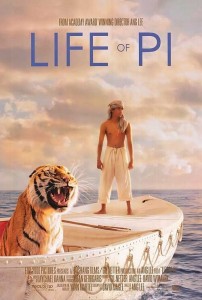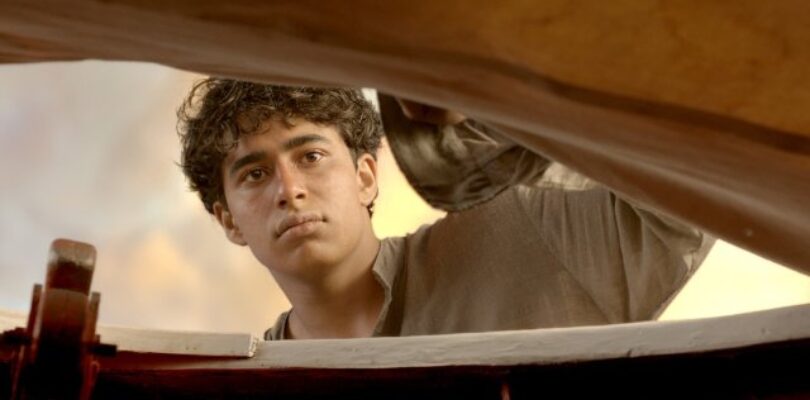 To dispense with the obvious, Life of Pi is a technical marvel that seamlessly captures the essential (some would think unfilmable) central story of a young man trapped on a lifeboat in the company of a large Bengal tiger. Yann Martel’s novel struck a chord with this intriguing high concept by tapping into a magnanimous humanism in the form of one boy’s interest in all religions (casually ignoring dogma) and philosophies. As a teenager, the boy “Pi” Patel loses his zookeeping family and most of their menagerie in a devastating boat accident that rivals the Titanic sinking in a spectacular sequence. Many have read Life of Pi and will surely be curious to see the 3D visual feats accomplished by hard-to-pin director Ang Lee – they will not be disappointed by the spectacle though a leaden, anticlimactic framing device and zen-lite revelations about the nature of faith and knowledge could strike many as hollow and unsophisticated.
To dispense with the obvious, Life of Pi is a technical marvel that seamlessly captures the essential (some would think unfilmable) central story of a young man trapped on a lifeboat in the company of a large Bengal tiger. Yann Martel’s novel struck a chord with this intriguing high concept by tapping into a magnanimous humanism in the form of one boy’s interest in all religions (casually ignoring dogma) and philosophies. As a teenager, the boy “Pi” Patel loses his zookeeping family and most of their menagerie in a devastating boat accident that rivals the Titanic sinking in a spectacular sequence. Many have read Life of Pi and will surely be curious to see the 3D visual feats accomplished by hard-to-pin director Ang Lee – they will not be disappointed by the spectacle though a leaden, anticlimactic framing device and zen-lite revelations about the nature of faith and knowledge could strike many as hollow and unsophisticated.
Ang Lee’s work is catholic to say the least but for every Crouching Tiger, Hidden Dragon and The Ice Storm he gives us misfires like Taking Woodstock or an overly somber Hulk. He is a modern director with many interests and no home; it is hard to pinpoint an Ang Lee film except to say that he seems intent on being a director of “quality” motion pictures with few traits (besides a methodical pacing) to help us discern what makes him passionate to shoot a particular story. Originally, Life of Pi was to be helmed by the wacky visual fantasist Jean-Pierre Jeunet of Amelie and City of Lost Children fame; we can imagine the bounce and humor he would have brought to the same proceedings Lee approaches with reverence and hesitation. A perilous adventure with minimal stakes since the film makes the dramatically inert decision to let the grown Pi Patel recount his unlikely adventures to an easily awe-stricken journalist.
Left adrift in the Pacific Ocean after the boat sinks, Pi remains in the company of three surviving animals, two of which are quickly dispatched with PG-rated CGI ferocity by Pi’s stowaway, “Richard Parker,” the spoken-of tiger kept at bay only by the boy’s keen intelligence and moral purity. The new age-y business of Pi communing with the cosmos and steeling his soul with compassion detracts from what might have been a great Robert Louis Stevenson-like natural adventure, but plays like Robinson Crusoe reading “Be Here Now” filmed by the director of What Dreams May Come.

Suraj Sharma in “Life of Pi.” © 2012 – Twentieth Century Fox Film Corporation. All rights reserved.
Much will be said about the crayon box of colors in the film’s rich palette and the feats of digital wonder that were able to meet the demands of Pi’s fantastic tale. It is a stunner to watch and get lost in behind 3D glasses and will lose most of its appeal on 2D screens, but the drama will remain rather flat no matter which format you choose.
I wanted a sense of wonder that would make me forget any intellectualism and have tears rolling down when Pi came to the end of his journey; another filmmaker’s choices might have drawn that from me, but Ang Lee plays it too safe, giving assurances along the way like an anxious homing bird and cutting the metaphysical intentions with a vague and frustrating turn at the end of the picture that could render the entire epic moot except for its themes of mythmaking in the interest of a good story.
A sparkling pop-up book of a film in which every visual is to be savored with a meticulous demand created by a sometimes shapeless director, Life of Pi has admirable warmth and optimism which strive for profound but offer no more than dashes of Eastern philosophy with a garnish of Christian dominance.[box_info]WHERE TO WATCH (powered by JustWatch)
[/box_info]

